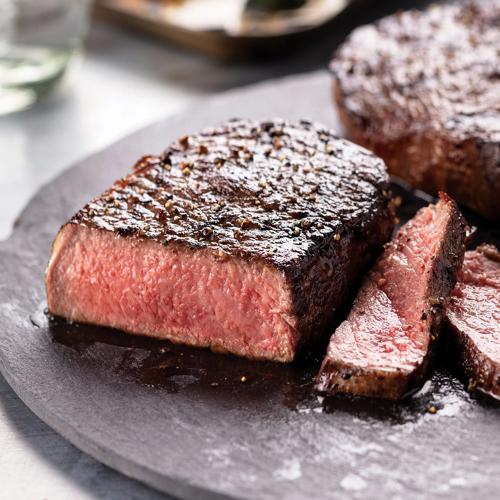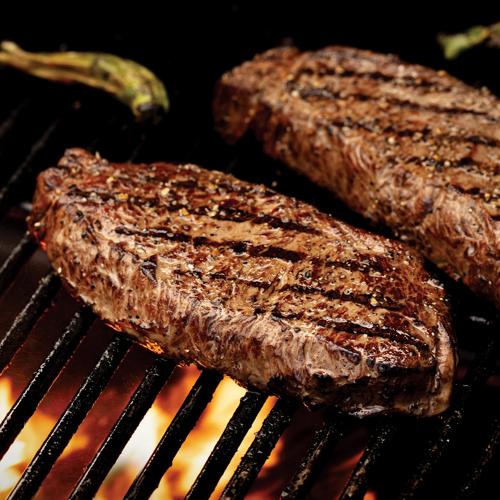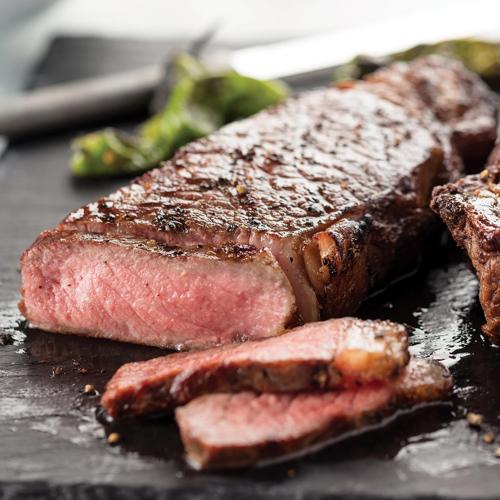The strip steak is known by many names: New York strip steak, ambassador steak, strip loin steak, Kansas City strip, club steak, or the Omaha Strip… but most people call it New York Strip. So why did “New York” stick? Simple: that’s where it all began – the great steakhouses of New York City.
But the name’s not what makes the steak a butcher’s favorite and a people’s choice. With your first bite, you’ll be so wrapped up in the bold, beefy flavor you won’t care what you called it in the first place.
So how is a New York Strip cut and what gives it that robust flavor and great texture?
Cutting a New York Strip Steak
The New York strip is cut from the beef short loin subprimal, which is part of the loin primal. The loin primal is the source of many premier steak cuts – including the most tender of them all – the filet mignon. When the tenderloin is removed from the short loin, the beef strip loin remains. This subprimal is only about 16-18 inches long and will yield 11-14 steaks, depending on thickness.
The New York strip is cut from the beef short loin, sometimes with the bone attached but most often as a boneless steak. If the butcher leaves the strip loin and tenderloin intact through the short loin, the short loin will transform into T-bone and porterhouse steaks.
NY Strip’s Bold Flavor & Medium Texture
The New York strip has intense flavor, with bold, beefy notes. It’s not the most tender steak – one of the reasons people love it is for its great bite and solid chew. The rich marbling inherent in this steak creates the robust flavor and a delicious eating experience. Omaha Steaks ages strips – and all of steaks – in carefully controlled conditions for at least 28 days, which naturally brings out the full tenderness of the beef.
Bone-in vs Boneless New York Strip
Most of the time, our butchers cut these steaks as boneless New York strips, but there’s usually an option to have the bone left in. A bone-in steak looks great, but it’s not just for show…
When the strip and filet are separated, the butcher may leave that middle bone with the strip. The bone insulates the meat while cooking, which allows the steak to retain moisture and juiciness. However, bone-in strip requires more culinary skill for the perfect doneness. When you cook a bone-in steak, the portion closer to the bone cooks slower and the meat farther from the bone will cook faster.
How to Cook a New York Strip
The New York Strip is often called “the ultimate griller’s steak,” especially here at Omaha Steaks. Our butchers and experts recommend a grilling strips on a super-hot grill, quickly, to give the steak a great sear without overcooking. If you cook a NY strip indoors, pan-roast or reverse-sear are the best methods.
When grilling a New York strip, follow this steak cooking chart or download the Omaha Steaks app with a built-in timer to cook your steak to a perfect doneness.
When you are buying NY Strip steaks, a good one should have plenty of marbling – the small white lines of fat within the meat. No matter how you cook it, this marbling melts into the meat to infuse it with the boldest flavors among any popular steak.
Dry-Aged Bone-in New York Strips
Dry aging any steak adds another layer of strong flavor. For an extra-bold New York strip, try a dry-aged bone-in New York strip. Dry-aging beef concentrates the flavor and breaks down the connective tissue in the muscle creating natural tenderness in the beef and that amazing taste. Aged a full sixty days in carefully controlled conditions and hand-carved by our master butchers, Omaha Steaks dry-aged strips are super-rich with deep, earthy beef flavor with exceptional tenderness.
More Articles:
More Butcher’s Guides:
- What is a Ribeye?
- What is an Omaha-Cut Ribeye?
- What is a Filet Mignon?
- What is a T-bone?
- What is a Tomahawk Steak?
- What is a Top Sirloin?

Be A Gift Giving All-Star
Shop for delicious steak gifts everyone is sure to love. Guaranteed.







